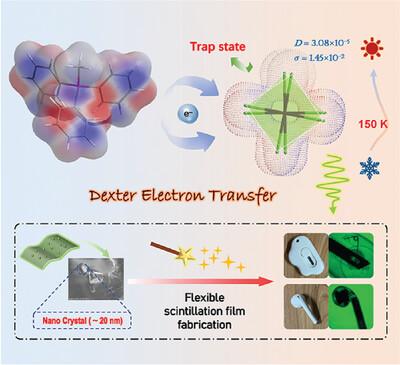当前位置:
X-MOL 学术
›
Laser Photonics Rev.
›
论文详情
Our official English website, www.x-mol.net, welcomes your
feedback! (Note: you will need to create a separate account there.)
High‐Resolution X‐Ray Imaging With 0D Organic–Metal Halide Scintillator Featuring Reversed Exciton Trapping
Laser & Photonics Reviews ( IF 9.8 ) Pub Date : 2024-11-08 , DOI: 10.1002/lpor.202401342 Rui‐Xuan Qian, Jian Lu, Meng Cui, Shuai‐Hua Wang, Peng‐Kun Wang, Bao‐Yi Li, Fa‐Kun Zheng, Guo‐Cong Guo
Laser & Photonics Reviews ( IF 9.8 ) Pub Date : 2024-11-08 , DOI: 10.1002/lpor.202401342 Rui‐Xuan Qian, Jian Lu, Meng Cui, Shuai‐Hua Wang, Peng‐Kun Wang, Bao‐Yi Li, Fa‐Kun Zheng, Guo‐Cong Guo

|
Scintillators, essential for applications in nuclear medicine, radiation detection, and industrial inspection, convert high‐energy radiation into visible light. Manganese (Mn)‐based inorganic–organic hybrid materials are distinguished by their thermal stability, mechanical strength, and flexibility. However, the effects of temperature on Mn(II)‐based hybrid scintillators have not been clearly analyzed, making the elucidation of their temperature‐dependent luminescence mechanisms particularly important. A notable advancement is the synthesis of Mn‐1 nanocrystals (NCs) using methyltriphenylphosphonium chloride (mtppCl) and MnCl₂. These NCs exhibit distinctive temperature‐dependent photoluminescence luminescence: the intensity decreases from 77 to 150 K but paradoxically increases at higher temperatures due to anomalous thermal exciton behavior in the [MnCl₄]2 ⁻ tetrahedra. Besides, Mn‐1 NCs achieve a detection limit of 1.01 µGyair /s, surpassing medical diagnostic standards and outperforming commercial scintillators such as Bi₄Ge₃O₁₂ (BGO). Additionally, they show exceptional stability under continuous irradiation and can be incorporated into a flexible scintillating film with a resolution of 11.3 lp/mm at an MTF of 0.2. The current study has further refined the luminescence mechanism of Mn(II)‐based materials and optimizes their properties for a wider range of applications.
中文翻译:

使用具有反向激子捕获功能的 0D 有机-金属卤化物闪烁体进行高分辨率 X 射线成像
闪烁体对于核医学、辐射检测和工业检查应用至关重要,可将高能辐射转化为可见光。基于锰 (Mn) 的无机-有机杂化材料以其热稳定性、机械强度和柔韧性而著称。然而,温度对基于 Mn(II) 的混合闪烁体的影响尚未得到明确分析,这使得阐明它们与温度相关的发光机制尤为重要。一项显著的进展是使用甲基三苯基氯化膦 (mtppCl) 和 MnCl₂ 合成 Mn-1 纳米晶体 (NC)。这些 NC 表现出独特的温度依赖性光致发光:强度从 77 K 降低到 150 K,但由于 [MnCl₄]2⁻ 四面体中的异常热激子行为,在较高温度下自相矛盾地增加。此外,Mn-1 NC 的检测限为 1.01 μGyair/s,超过了医学诊断标准,性能优于 Bi₄Ge₃O₁₂ (BGO) 等商业闪烁体。此外,它们在连续照射下表现出卓越的稳定性,并且可以在 0.2 的 MTF 下掺入分辨率为 11.3 lp/mm 的柔性闪烁薄膜中。目前的研究进一步完善了 Mn(II) 基材料的发光机制,并优化了它们的性能以用于更广泛的应用。
更新日期:2024-11-08
中文翻译:

使用具有反向激子捕获功能的 0D 有机-金属卤化物闪烁体进行高分辨率 X 射线成像
闪烁体对于核医学、辐射检测和工业检查应用至关重要,可将高能辐射转化为可见光。基于锰 (Mn) 的无机-有机杂化材料以其热稳定性、机械强度和柔韧性而著称。然而,温度对基于 Mn(II) 的混合闪烁体的影响尚未得到明确分析,这使得阐明它们与温度相关的发光机制尤为重要。一项显著的进展是使用甲基三苯基氯化膦 (mtppCl) 和 MnCl₂ 合成 Mn-1 纳米晶体 (NC)。这些 NC 表现出独特的温度依赖性光致发光:强度从 77 K 降低到 150 K,但由于 [MnCl₄]2⁻ 四面体中的异常热激子行为,在较高温度下自相矛盾地增加。此外,Mn-1 NC 的检测限为 1.01 μGyair/s,超过了医学诊断标准,性能优于 Bi₄Ge₃O₁₂ (BGO) 等商业闪烁体。此外,它们在连续照射下表现出卓越的稳定性,并且可以在 0.2 的 MTF 下掺入分辨率为 11.3 lp/mm 的柔性闪烁薄膜中。目前的研究进一步完善了 Mn(II) 基材料的发光机制,并优化了它们的性能以用于更广泛的应用。


















































 京公网安备 11010802027423号
京公网安备 11010802027423号